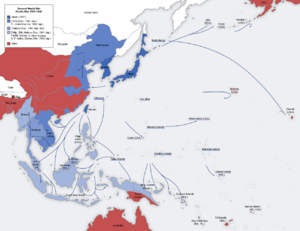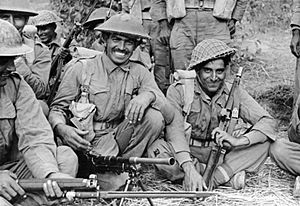Arakan Campaign 1942–43 facts for kids
Quick facts for kids Arakan Campaign 1942–1943 |
|||||||
|---|---|---|---|---|---|---|---|
| Part of the Burma Campaign | |||||||
 Royal Indian Navy landing craft carry Indian troops along a tributary of the Kaladan. |
|||||||
|
|||||||
| Belligerents | |||||||
| Commanders and leaders | |||||||
| Strength | |||||||
| 4 brigades rising to 9 brigades 5 motor launches 72 landing craft 3 paddle steamers |
1 regiment rising to 1 division |
||||||
| Casualties and losses | |||||||
| 916 killed 4,141 wounded and missing |
611 killed 1,165 wounded (estimated) |
||||||
The Arakan Campaign of 1942–43 was the first major attack by the Allied forces into Burma. This happened during World War II, after Japan had taken control of Burma earlier in 1942. The British and Indian armies were not fully ready for fighting in the tough jungle and mountains. Also, the supply lines and support systems in eastern India were not set up to help the army on the border. Japanese soldiers had strong defenses and repeatedly pushed back the British and Indian troops. When the Japanese received more soldiers, they counter-attacked, forcing the Allies to retreat.
Contents
Why Did the Campaign Start?
The Situation in 1942
In May 1942, Allied troops and many refugees had to leave Burma. They moved into India. The Japanese stopped their advance at the Chindwin River. This was mainly because heavy monsoon rains made the roads and paths impassable.
However, the Allies, especially the British in India, worried that Japan would attack again. This was expected after the monsoon season ended. At the same time, the British government in India faced big problems. There was widespread disorder and a growing famine in eastern provinces like Bengal. This famine became very serious in 1943.
The British changed how their army was organized in eastern India. Lieutenant General Noel Irwin was in charge of the main fighting forces. These forces included the 14th Indian Infantry Division. This division was near Chittagong and faced the Burmese coast, called Arakan.
Allied Plans for Attack
General Archibald Wavell, the top commander in India, wanted to attack Burma. He started planning even while his troops were retreating. In most areas, new roads and supply routes were needed. This would take at least a year to build.
But on the Arakan front, the distances were shorter. It seemed possible to get supplies ready by the end of the monsoon. However, improving the poor roads still delayed the attack until mid-December 1942.
The main goal of the British attack in Arakan was to capture Akyab Island. This island had a port and an airfield that could be used all year. Capturing Akyab was important for Allied plans to take back Burma. From Akyab, planes could reach most of Central Burma. Bombers could even reach Rangoon, the capital of Burma.
Akyab Island was at the end of the Mayu Peninsula. This peninsula had a narrow, steep, jungle-covered mountain range called the Mayu Range. This range separated the coastal plain from a fertile valley. The only main route across the range was an old railway track. It had been turned into a road linking Buthidaung with the port of Maungdaw.
Wavell's plan to capture Akyab was called Operation Cannibal. At first, they planned a sea attack on Akyab. But the special landing ships and troops needed were not available in time. So, the plan changed. The 14th Indian Division would advance down the Mayu peninsula. Once they reached the southern tip, they would try to cross a narrow channel to Akyab Island. By late December, some motor launches and landing craft were ready.
The Battle Begins
The Advance Starts
The 14th Indian Division began its advance on December 17, 1942. They moved south from Cox's Bazar, near the border between India and Burma. The Japanese defending Arakan were called "Miyawaki Force." This force was led by Colonel Kosuke Miyawaki.
The Japanese had built strong defenses. But they were ordered to pull back to the main Japanese force. This allowed the 14th Indian Division to capture the Maungdaw-Buthidaung road on December 22.
The Attack Slows Down
At this point, Colonel Miyawaki learned that a new Japanese division was coming to Arakan. This was the Japanese 55th Division, led by Lieutenant General Takeshi Koga. Miyawaki was ordered to move forward and secure positions at Donbaik and Rathedaung.
On December 28, Japanese troops took Rathedaung. They stopped the Indian 123rd Infantry Brigade from capturing the town. On January 9–10, new attacks on Rathedaung were also pushed back.
Most of Miyawaki's remaining troops went to Akyab. But a small Japanese company held a narrow area north of Donbaik. This area was protected by a chaung (a tidal creek) with high banks. The Japanese built strong, hidden bunkers made of wood and earth. Between January 7 and 9, the Indian 47th Infantry Brigade attacked this line but was stopped. The bunkers were too strong for their artillery. If British or Indian soldiers got close, the Japanese could call for artillery fire on their own positions.
Wavell and Irwin visited the front on January 10. The British commander, Major General Wilfrid Lewis Lloyd, asked for tanks to destroy the bunkers. On February 1, the Indian 55th Infantry Brigade attacked Donbaik with only eight Valentine tanks. Some tanks got stuck, and others were destroyed. The attack failed. Two days later, another attack on Rathedaung also failed.
More Japanese troops arrived from Central Burma. They cleared out British irregular forces who were threatening Japanese supply lines. These irregular forces warned the British that many Japanese soldiers were coming.
Last British Attacks
After their defeats at Donbaik, the Indian 47th and 55th Brigades moved east of the Mayu Range. In early March, Japanese troops crossed the Mayu River. They attacked the Indian 55th Brigade, forcing it to retreat. This left the Indian 47th Brigade alone north of Rathedaung.
Even with this danger, General Irwin demanded another attack on Donbaik. This time, he used the strong British 6th Brigade. On March 10, Lieutenant General William Slim reported that the 14th Indian Division was struggling. It had too many brigades to command, and morale was low. But Irwin did not make changes yet.
For the next attack on Donbaik, Lloyd planned a flanking move. But Irwin had lost faith in Lloyd. Irwin took over the planning himself. He ordered the British 6th Brigade, with six battalions, to attack directly. The attack happened on March 18. More Japanese troops had reinforced Donbaik. Despite heavy artillery, the 6th Brigade could not break through the bunkers. They suffered 300 casualties. After this, Wavell and Irwin ordered the troops to hold the ground they had.
Japanese Counter-attack
On March 25, Lloyd ordered the isolated 47th Indian Brigade to pull back. But Irwin canceled the order and removed Lloyd from command on March 29. Irwin took personal command of the 14th Division until the Indian 26th Division could take over.
On April 3, Japanese forces pushed north. The main Japanese 55th Division crossed the Mayu Range. British officers had thought this area was impossible to cross. The Japanese cut the coastal road behind the British troops. They attacked on the night of April 5 and captured Indin village. They also took over the headquarters of the British 6th Brigade and captured its commander. The 47th Indian Brigade had to retreat in small groups, leaving all their equipment behind.
Lieutenant General Slim's XV Corps headquarters finally took charge of the Arakan front. Slim saw that the troops were tired and had low morale. However, he and Major-General Cyril Lomax expected the Japanese to try to capture the Maungdaw-Buthidaung road. They planned to surround and destroy the Japanese.
In late April, the Japanese attacked north, as Slim and Lomax had predicted. They met strong resistance on the sides. So, they advanced in the middle instead. On May 4, a British battalion defending a hill gave way. This allowed the Japanese to cut the Maungdaw-Buthidaung road. Counter-attacks failed. British and Indian troops in Buthidaung were cut off. They had to destroy their vehicles and retreat north.
Irwin ordered that Maungdaw should be held. But Slim and Lomax decided the port was not ready for a siege. They also feared the tired troops could not defend it well. On May 11, the port was abandoned. XV Corps fell back to Cox's Bazar in India. The open land there gave an advantage to British artillery. The monsoon rains also started, stopping the Japanese from chasing them further.
What Happened Next?
Leaders like Irwin and Slim openly discussed why the Arakan campaign failed. The main reason was that British and Indian soldiers were not properly trained for jungle fighting. This, along with repeated defeats, hurt their morale. Poor support and supplies from India also made things worse. Sometimes, new soldiers sent as replacements had not even finished their basic training.
Lieutenant General Irwin tried to remove Slim from command. But Irwin himself was removed from command of Eastern Army. He returned to Britain due to illness. His replacement was General George Giffard. Giffard focused on improving the army's morale, health, and training.
Around this time, the first Chindit raid, led by Brigadier Orde Wingate, ended. Its successes were widely shared to help counter the bad news from Arakan.
Later, there were changes in top leadership. Wavell became the Viceroy of India, and General Claude Auchinleck became the Commander in Chief in India. The Indian Army was reorganized to focus on fighting in Burma. This led to success in the next two years.



